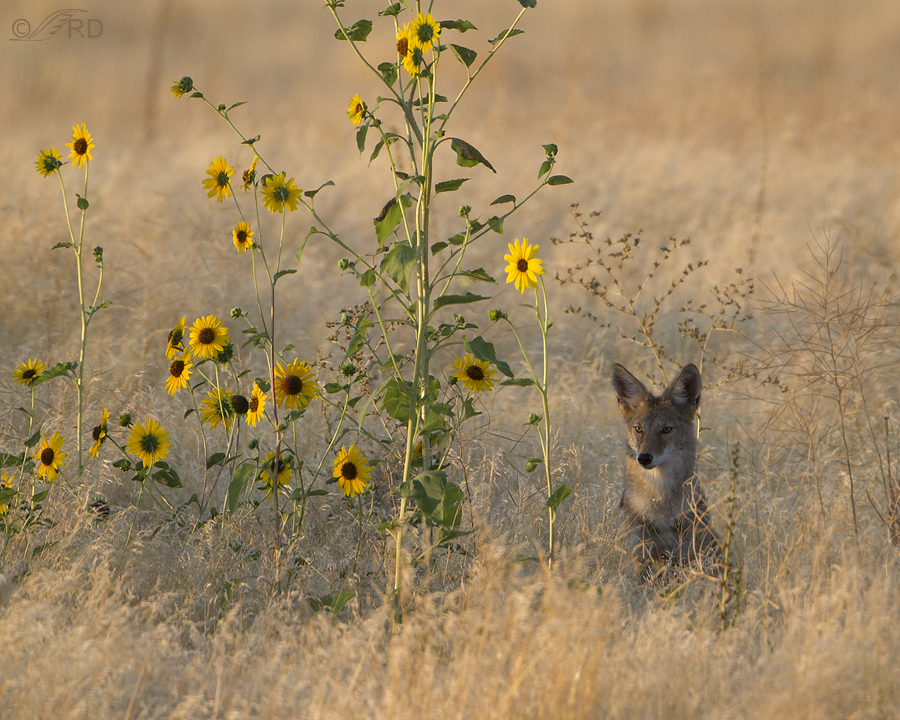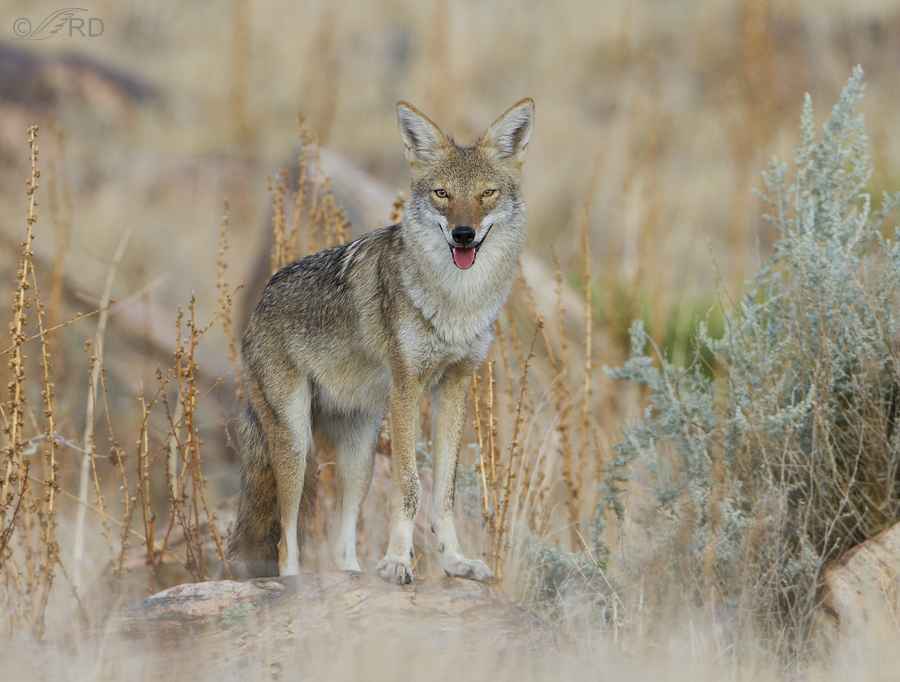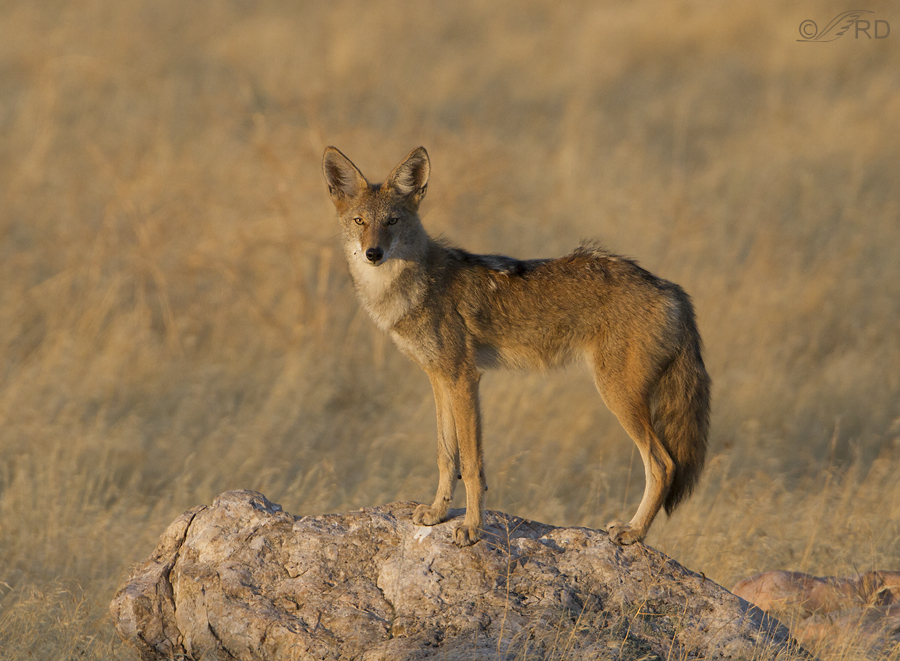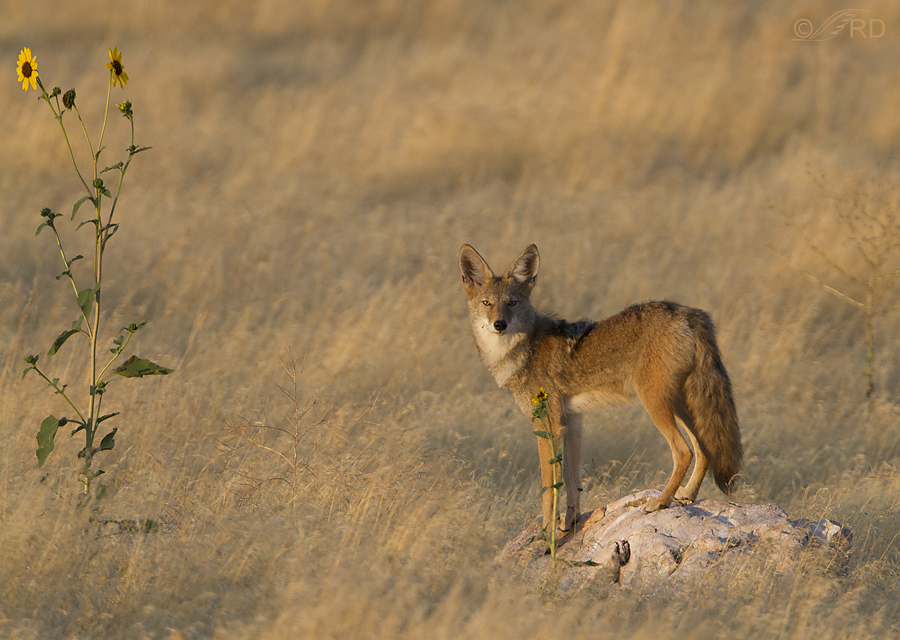A perch (when it’s not a fish) is defined as “a roost for a bird” or “a prominent resting place”. Most of the perched critters I photograph have feathers, but not all of them. Many mammals like to perch up high on rocks, small hills or other natural or man-made structures in order to have a better view of their surroundings. In the case of predators, like coyotes, they often do so while looking for prey. Some small mammals (prairie dogs and ground squirrels, for example) often elevate their position in order to watch for predators.

1/1000, f/6.3, ISO 640, 500 f/4, 1.4 tc
Getting a clear, relatively unobstructed shot of a coyote can be very difficult because of the types of habitat they tend to prefer. But sometimes I don’t think it’s necessary to get them in the clear. This coyote was hunting voles just as the sun was coming up. It deliberately placed itself in the shade of the sunflowers to be less easily seen as it watched and listened for rodents. Even though only about half of the coyote is visible, I still like the shot because it shows behavior and I think the sunflowers add a nice touch. There’s just enough light in the right eye to make this work for me.

1/2500, f/7.1, ISO 500, 500 f/4, 1.4 tc
But when the coyote alone is the primary subject of the image, a relatively clear view of the entire animal is often preferred. That’s when the photographer can take advantage of the tendency of coyotes to get on elevated perches.

1/320, f/8, ISO 500, 500 f/4, 1.4 tc
Sometimes the setting is still a little busy with vegetation but if you have a clear view of the animal it can still make for a strong image, especially if you get eye contact.

1/1600, f/6.3, ISO 640, 500 f/4, 1.4 tc
If you’re lucky, the background will be far enough away from the coyote to be nicely softened, which helps bring the focus of the eye to the subject.

1/1250, f/6.3, ISO 640, 500 f/4, 1.4 tc
But having other natural elements in the setting can be interesting too. Here, I have the choice to include the sunflower at left or to crop it out.

1/1000, f/7.1, ISO 500, 500 f/4, 1.4 tc
I like this image because of the naturally slanting perch, good eye contact and nicely blurred background. The tail and feet can’t be seen but for me other strengths of the image help to mitigate that issue.
And the fact that the coyote looks all tuckered out just makes me smile.
Ron


Great set! I have yet to see them “perched”…but now that winter is around the corner I expect to see more of them out and about. Which means you’ll have more shots, right? 🙂 And maybe one or two for me lol
Thanks Mavourneen, I got close to several of them this morning but the light really sucked out there.
Great work on the Yotes — Love these !!
Simply stunning. I adore coyotes — such intelligent creatures. And these images of usually shy critters are just beautiful. While the perched captures are perfect, I can’t help but love the sunflower portrait. 🙂
I agree Christina, there’s just something appealing about having those sunflowers in the setting.
Great photos of one of my favorite animals, Ron. The last image held my attention for quite a while. I think it would be a good candidate for a “submit your own caption” contest. Thanks!
I’d never thought of doing a contest like that Dick – might have to consider it…
Superb series of photos!!!
Thanks Nicole.
Ron, I’m a frequent visitor but an infrequent responder, mostly as I have little to add to the conversation but a “wow”. I learn much here and marvel at your photos, though, and these are fabulous – I can certainly be convinced of there being personalities behind those faces.
Thank you Sid. I agree that it’s hard not to see personality in those expressive faces.
Good to see the mammal stuff as different to the sky back ground of birds . I would say the sunflowers represent the delicate flight of birds next to our kindred mammal ,coyote. i will be going down to the Outer Banks N. C. to visit family . I will be looking for your birds and will have a piece of your work with me as I make my observations.
Good luck with the birds on your trip Eldridge.
Excellent series of photos, Ron. I especially like the 3rd one (#4795). It looks like a Syl Lobatto painting. She is a fellow blogger that paints wildlife. I love to see grasses and other habitat included when possible.
Thank you Bob. I’ve noticed Syl’s internet presence, I’ll have to check out her paintings.
It is obviously hard work being a predator. I love the fact that both the predator and the prey choose elevated positions for their own advantage. I really enjoyed this series – thank you. How did the sunflowers get there, do you know? Bird droppings?
Thanks Elephant’s Child. These sunflowers, Helianus annus I believe, are found throughout Utah in the drier regions. I’m not sure how they got on the island but birds would be high on my list.
Fantastic photos of a favorite four footed trickster! I love the one with the splayed front feet!
Thank you, Tana.